The mana system of MTG is one of the most important mechanics in the entire game. Each color traditionally gets access to specific types of cards and strategies, and powerful cards typically cost more mana than weaker cards.
Since you can only play 1 land a turn, you’re gradually able to escalate the power level of your plays. Some cards are still more powerful or efficient than others, but the balance of mana costs keeps things in relative check throughout the course of a game.

But what if you could break that cycle? What if you could play your 7, 8, or even 10 mana cards on turns 2, 3, or 4?
As it happens, that’s been possible for years. The Moxen and Black Lotus, lands like Tolarian Academy, the Affinity mechanic, Stoneforge Mystic, Aetherworks Marvel – all of these circumvent the traditional flow of a game and allow you to rocket, if not outright jump, straight to the finish line of your deck’s game plan.
While each of these cards is fairly unique in how it breaks the game of Magic, there’s one strategy in this vein that actually receives support to this day, and it breaks the game almost as efficiently, even in Commander.
So get your Eldrazi, Angels, Dragons, and other big expensive creatures ready, because we’re going to talk about the commanders that will help you take the fullest advantage of reanimator cards.
What is Reanimator?

Reanimator strategies traditionally focus on placing high converted mana cost (CMC) creatures in your graveyard, then use low CMC cards (usually 3 or less, almost never more than 5 CMC) to revive them onto the battlefield. You can also adapt this idea to other types of permanents like artifacts and enchantments, but creatures are by far the most common focus for reanimator decks.
There are lots of different ways to get creatures into your graveyard – perhaps you’ll place them there from your deck with a card like Entomb, discard them from your hand with spells like Faithless Looting, sacrifice them through an outlet like Ashnod’s Altar, or simply allow them to die over the course of normal gameplay.
Once your graveyard is full of badass creatures, reanimator spells like Reanimate and Animate Dead allow you to spend 1-2 mana instead of 6 or more to put your powerful creatures into play, thus allowing you to repeatedly impact the board in ways that only get more unfair as more powerful creatures are printed in new Magic: the Gathering sets.
Traits of Good Reanimator Commanders
- Low converted mana cost: Commanders like Tariel, Reckoner of Souls are a lot of fun to pilot – if the game lasts long enough for you to actually cast them. You’ll want a commander that you can get into play relatively quickly and is considered worthwhile even after a couple instances of Commander Tax.
- Relevance to the reanimator theme: It’s good practice to select a commander whose abilities and colors support the strategy of your deck, and reanimator is no exception to this rule. On that note, black is the color containing the majority of the best reanimator cards and support, so all entries on this list will contain black in their color identity.
- Minimal hoops to jump through: You shouldn’t have to go through several steps to exercise your reanimator commander’s full potential – playing the card and then doing up to 1 thing should result in a contribution to your game plan.
While all the legendary creatures we’ll be looking at have black as part of their color identity, I am going to cover a spread of different color combinations so you can choose the one best suited to your goals and playstyle. Any of these cards will make an excellent commander, so don’t assume a specific placement on the list has any bearing on power level or quality.
Tribal Reanimator Commanders (Scion of the Ur-Dragon, Horde of Notions, Gisa and Geralf, Kaalia of the Vast, etc.)
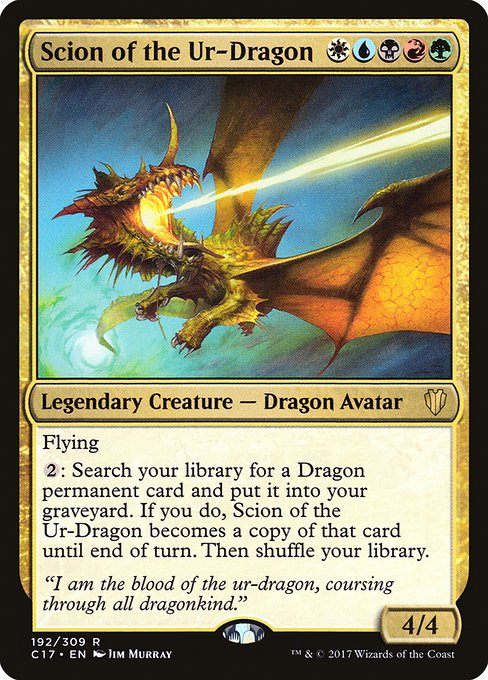
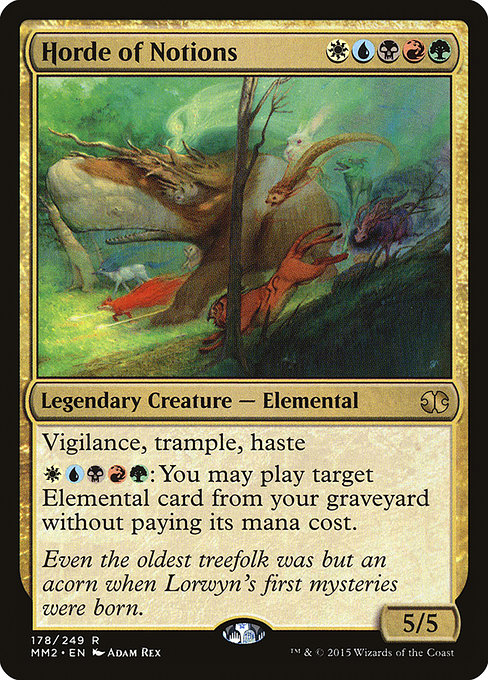
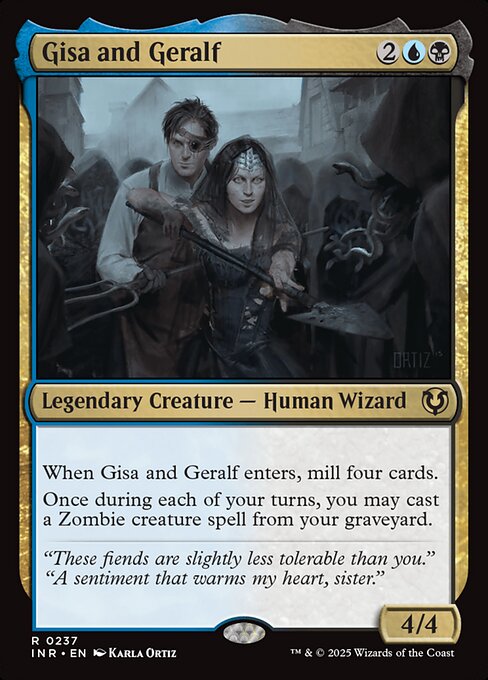
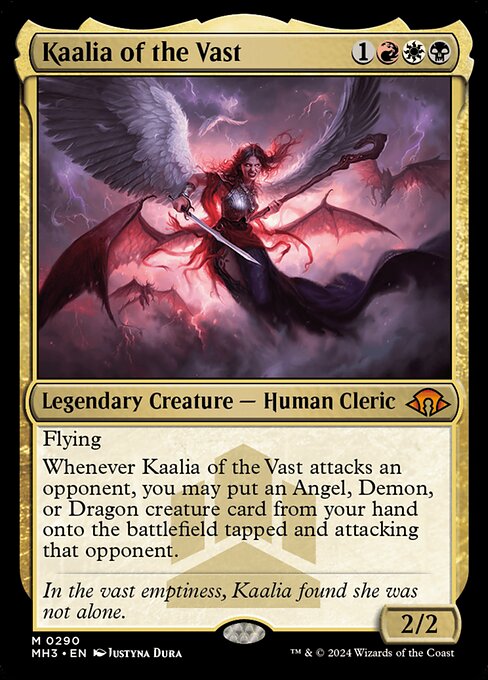
There are a LOT of commanders well suited to tribal reanimator strategies, but the 4 I have listed here exemplify what you should be looking for when narrowing down which legendary creature should be at the helm.
Scion of the Ur-Dragon offers an easy, repeatable way for you to search out dragons from your deck and put them into your graveyard, which is already a good enough ability on its own for fueling your reanimator cards. The fact that it becomes a copy of the dragon you search for is also awesome, as you’ll almost always net a power boost and/or a useful ability for the turn.
You can also activate it multiple times at once, and take advantage of the stack and a dragon’s activated abilities for combo potential. Finding a Moltensteel Dragon, pumping it up at least 6 times, then turning it into Skithryx, the Blight Dragon for lethal Infect damage in the middle of combat is a classic, but there are plenty of other shenanigans if you’re willing to explore the increasing pool of Dragons.
Horde of Notions and Gisa and Geralf operate similarly to one another, as you can cast your tribal cards directly from your graveyard at either their cost or a fixed cost.
Elementals can get pretty pricey, so 5 mana is often a cost reduction, and at instant speed, you can pull a lot of surprises outside your turn. Remember that changeling cards like Crib Swap and Nameless Inversion also count as Elementals, so while paying 5 mana for them might chafe, sometimes they’ll be exactly what you need to get out of a bind.
Zombies often have low CMC, so paying their mana costs allows you to save your reanimation spells for heavier hitters. Add in the free mill effect to help you get started, and you’ve got the makings of a very efficient operation by signing on with Gisa and Geralf.
Kaalia of the Vast is unique in that it rewards playing with 3 tribes instead of just 1, and gives you a way to play the traditionally big, expensive Demons, Dragons, & Angels from your hand simply for attacking. As your opponents deal with these threats, most will usually end up in your graveyard, so you’ll be well situated to keep cheating them back into play from there once you get going.
One word of caution with any of these commanders (but especially Kaalia) – don’t revolve your entire game plan solely around using their abilities. Experienced players will kill them on sight, so you’ll want to be sure you have other methods for filling your graveyard and reanimating your creatures on standby.
On the bright side, any targeted removal aimed at your commander also isn’t being aimed at your primary threats.
Meren of Clan Nel Toth

Do you like value? Do you enjoy accruing it simply by playing a game of Commander without having to jump through a bunch of extra hoops? Meren of Clan Nel Toth might be the commander you never knew you needed.
At low converted mana costs, you can easily take advantage of graveyard setup creatures like Hermit Druid, pull different types of cards back to your hand with Eternal Witness, or even ramp with Wood Elves.
As your creatures die and your experience counters build (a scenario that is very easy to accomplish through the use of a board wipe while Meren is in play), you’ll get to bring back bruisers like Razaketh, the Foulblooded or Sepulchral Primordial to start closing out the game.
The best part? Even if your opponents are keeping you from accumulating experience counters, returning creatures (especially those with lower CMC) to your hand is still quite useful! While putting them directly into play is admittedly more efficient, there’s really no downside with Meren’s ability – only good scenarios and better ones.
Karador, Ghost Chieftain
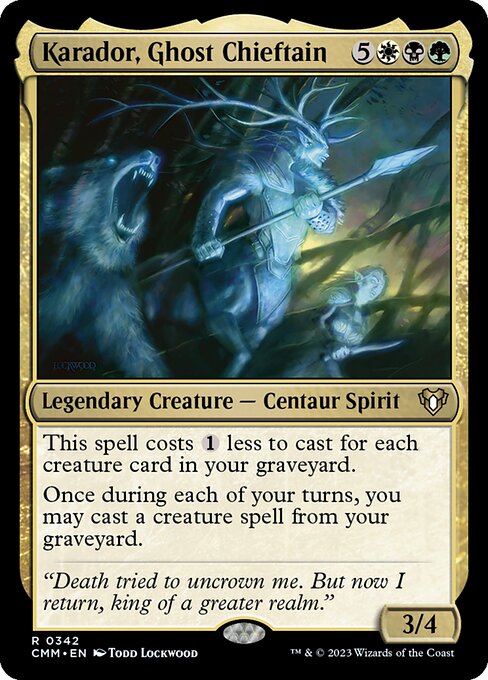
I’ve piloted a Karador, Ghost Chieftain deck for many years, and there are a couple reasons this is considered a classic reanimator commander.
First, Abzan decks offer you what many would consider the strongest pool of cards for building a reanimator deck. Black and white both offer a wide selection of reanimator spells, green gives you access to the best mana ramp, and all 3 colors have high CMC creatures capable of significant board impact or closing a game outright.
Second, the cost reduction mechanic usually doesn’t allow you to cast Karador super early (barring something like a Hermit Druid), but it does help you set up combo plays with creatures in your graveyard during the mid-late game. Don’t have a lot of mana? Play a utility creature. Mana flooded? Bring back your favorite bruiser.
And if it dies, no big deal – Karador’s cost reduction can also soak Commander Tax.
So why would you play Karador over other excellent Abzan commanders like Kethis, the Hidden Hand or Nethroi, Apex of Death? I feel Karador strikes the best balance between the utility and cost of reanimation in this space, as Kethis pushes you heavily toward a legendary theme, and Nethroi’s ability both costs a lot and truly thrives when you can bring back a zillion cheap creatures.
That said, you’ll probably still be utilizing at least a legendary creature subtheme with Karador, as Loyal Retainers is pretty much the perfect partner in crime. Repeated resurrection of huge threats like Avacyn, Angel of Hope, Kokusho, the Evening Star, or Vorinclex, Voice of Hunger for a mere 3 mana is simply more than many pods can bear.
Want to try it for yourself? You can check out my decklist here.
Muldrotha, the Gravetide
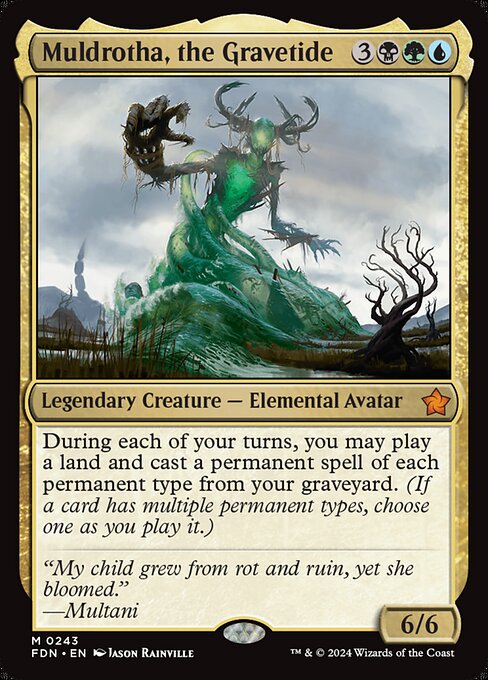
Muldrotha, the Gravetide was the first legendary creature to truly make me consider swapping white for blue in my reanimator deck. The ability to reuse any low CMC permanent opens the way to abuse with cards like Animate Dead, Necromancy, and Dance of the Dead while still letting you reuse Sakura-Tribe Elder and other efficient utility creatures.
This isn’t the only way you can build Muldrotha, however. Strategies utilizing multiple permanent types in 1 or more engines with low CMC cogs are also quite viable and extremely dangerous – even in environments with a reduced card pool. Don’t believe me? Check out this Game Knights video where Muldrotha cleans house in the Brawl format.
Chainer, Nightmare Adept
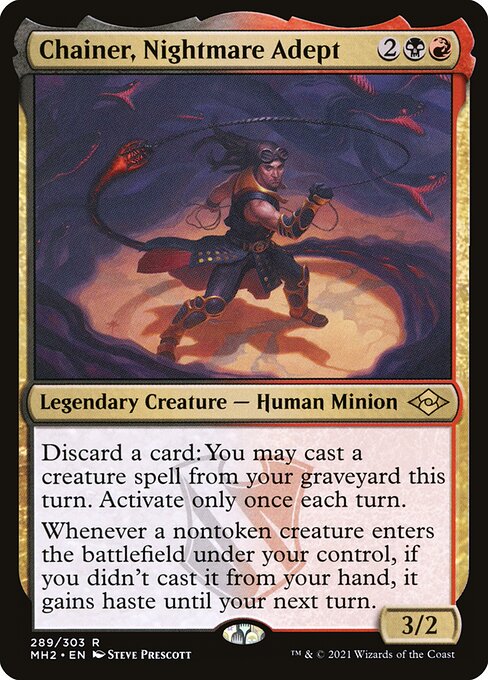
Haste is one of the most underrated keywords in all of Magic. Giving creatures the ability to attack or tap on the same turn they enter the battlefield under your control lets you quickly apply pressure to opponents through big stats, attack triggers, and powerful abilities the table would otherwise have a turn to respond to.
Factor in that reanimator decks typically want to bring back the biggest, baddest creatures of Magic‘s history as quickly as possible, and the pressure you’ll be applying through Chainer, Nightmare Adept will make you a quick believer of this simple truth.
Chainer doesn’t simply stop at giving all your reanimated creatures haste though. The cost of discarding a card can also be a great way to get a big creature out of your hand for a cheaper reanimation spell, allow you to set up evasion with a creature like Filth, or just turn that land you don’t need on turn 10 into whatever the biggest threat in your graveyard is instead.
Setup potential, speed, and reanimation capability in a package that doesn’t place heavy initial strain on your mana? Rakdos decks aren’t usually my jam, but I could easily be convinced to pilot this deck.
The Beamtown Bullies
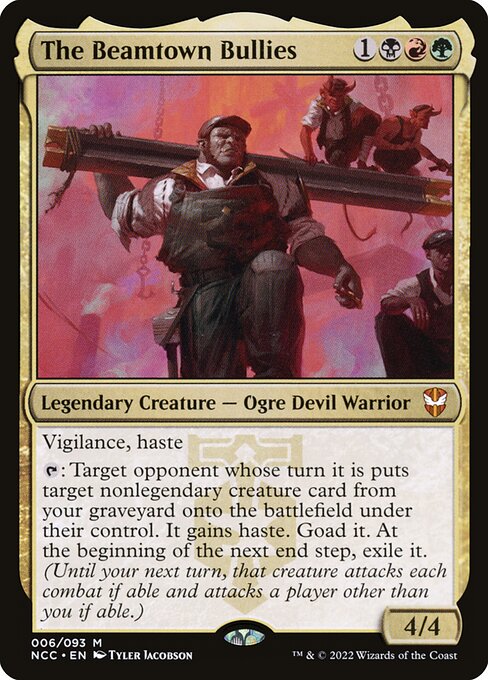
The Beamtown Bullies offer a twist on reanimator we haven’t really seen before – the ability to reanimate creatures directly onto an opponent’s battlefield from your graveyard. While I would normally not be excited about a card that has to tap to use its effect, a lot of care went into how this legendary creature was designed to ensure you’re able to use it to its fullest.
First, The Beamtown Bullies have haste AND vigilance. This means you’ll be able to attack someone right away without tapping them down, and be set up to use the reanimation ability further on in the turn rotation.
Next, the creature you reanimate with these bullies is goaded and given haste, meaning it must attack someone who isn’t you, then is exiled at the end of the turn, meaning it can’t be used against you during a future turn.
Finally, you have a wide selection of nonlegendary creatures that can be revived in Jund’s colors, allowing you to either give away a conventionally powerful creature like Balefire Dragon, or something hugely detrimental like Leveler.
As a fan of Zedruu, the Greathearted, I’m more inclined toward the latter, but beware blink decks if you go this route. The ability to return one of your “generous gifts” to your battlefield is all over a blink deck’s cards, so timing is very important in this matchup to avoid getting tripped up.
I’d also recommend keeping a few reanimation targets around for your own purposes. You’re going to be trying to put cards in your graveyard anyway, so you might as well lean into your deck’s theme and play black’s powerful suite of traditional reanimation spells while you’re at it.
Kenrith, the Returned King

Many of you are probably rolling your eyes and getting ready to point out that Kenrith, Returned King is a generic “good stuff” 5-color commander. And you’re right. I won’t deny it. One of his 5 abilities deals with reanimating creatures, however, and most of the others actually can play key roles in supporting this game plan, so don’t write this commander off so soon.
First, all the strengths of Chainer, Nightmare Adept apply here. 1 mana to give all your creatures haste puts a dangerous clock on life totals as you build up an army of huge threats. Big creatures + haste is a match made in heaven.
Second, the life gain effect can actually be very relevant. Reanimate, Life/Death, and good old fashioned attacks from your opponents can put a strain on your life total, so having an option for mitigation can get you through some tough spots.
Finally, the card draw and reanimation effects are inefficiently costed, even at instant speed, but that makes them far from irrelevant. A couple extra cards have tipped plenty of commander stalemates, and let’s be honest, a surprise Molten Primordial or Resolute Archangel is not only fun to pull out, it’s going to screw up combat math in a big way.
Just be sure not to target your opponents’ creatures for reanimation – the owner of the reanimated creature gets control of it.
Athreos, Shroud-Veiled
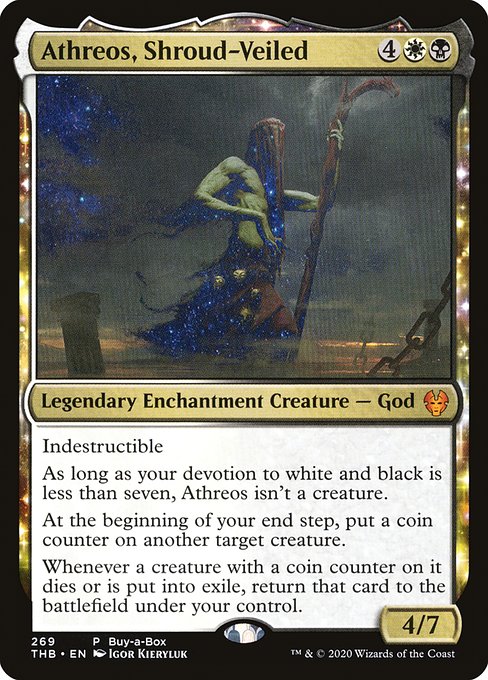
Effects that exile are one of the biggest threats to reanimator decks, as it is very difficult to return a card to your graveyard once it’s been removed from play. Board wipes like Cleansing Nova are also quite inconvenient, as they’ll clear both your threats and the commander helping you resurrect them.
Athreos, Shroud-Veiled provides insurance against both of these weaknesses by being indestructible, frequently avoiding creature status, and through use of its coin counters.
A coin counter can be placed upon any creature at the end of each of your turns, then when that creature dies or goes into exile, it comes back under your control. This means no matter who has the biggest creature at the table, it has the potential to eventually become yours.
If you don’t want your opponents’ creatures, yours still receive some insurance against effects like Path to Exile and Deadly Rollick, which can be extremely helpful if a creature like Avacyn, Angel of Hope is holding the rest of your board together.
My sole complaint is that Athreos costs 6 mana, which is an awful lot to ask for from the Command Zone, particularly given the incremental nature of its impact on a Commander game. On the bright side, it’s very rare you’ll need to cast it more than once, which isn’t something you can say about most commanders.
The Scarab God
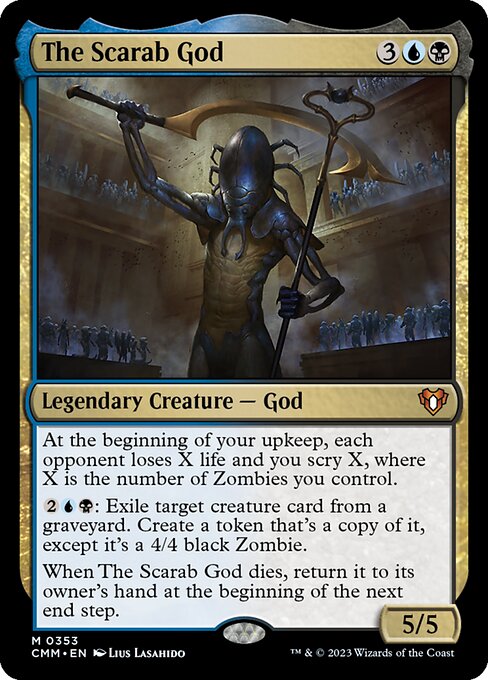
The Scarab God is an absolute powerhouse of a commander that can be built in a few different directions. Tribal Zombies, mill, and traditional reanimator builds are the most common, but over time, the abilities of this creature are inexorable enough to wear any pod down, regardless of your primary strategies.
While exiling creatures isn’t a traditional reanimator game plan, having access to 4/4 copies of any creature in your opponents’ graveyards, even at one time apiece, for 4 mana at instant speed can deliver incredible utility and card advantage in the mid-late game. Add a Training Grounds into the mix, and the value generated is absolutely ridiculous.
The icing on the cake comes during your upkeep, where you get to Scry X and make your opponents lose X life, where X is the number of Zombies under your control. I frequently forget this ability exists, because it’s almost always overkill, but the card filtering is insanely useful for finding a way to close the game.
Still not convinced of this card’s value? The last lines of text help it skirt Commander Tax by sending The Scarab God back to your hand every time it dies. This means you’ll almost always have access to a powerful 5/5 for 5 throughout the entire game.
I’ve had a lot of fun piloting the mill version of this deck (which wins more often through combat than mill these days!), so if you still need convincing, check out my decklist out for yourself here.
Sharuum the Hegemon

You don’t see Sharuum the Hegemon around nearly as much as you did in the early days of Commander, but don’t let the 6-mana price tag fool you – it’s still an incredibly formidable deck to play against.
As you’ve probably surmised from reading the card, Sharuum is a reanimator commander that focuses on artifacts. If you want to go the creature route, Metalwork Colossus, Phyrexian Triniform, Platinum Emperion, and Inkwell Leviathan are all top-notch powerhouses that Sharuum can drop on the field to establish an instant board presence.
If you prefer to build an indestructible fortress with Darksteel Forge before using Bolas’s Citadel to fish out one of the many infinite combos (mana, mill, turns, damage, etc.) artifact decks are known for, you can absolutely do that too.
The former is definitely the “fairer” version of a Sharuum deck, but artifact builds can be incredibly varied in both strategy and power level, so don’t be afraid to ask for a rough power assessment from its pilot before choosing your own to ensure a fun, interactive game for your pod.
How to Win with Reanimator
Your first route to victory is speed – playing bigger, better cards before your opponents will put you in control of a game and allow you to dictate how aggressively your opponents can play. Sometimes, you’ll be able to dominate a game before they even get off the ground.
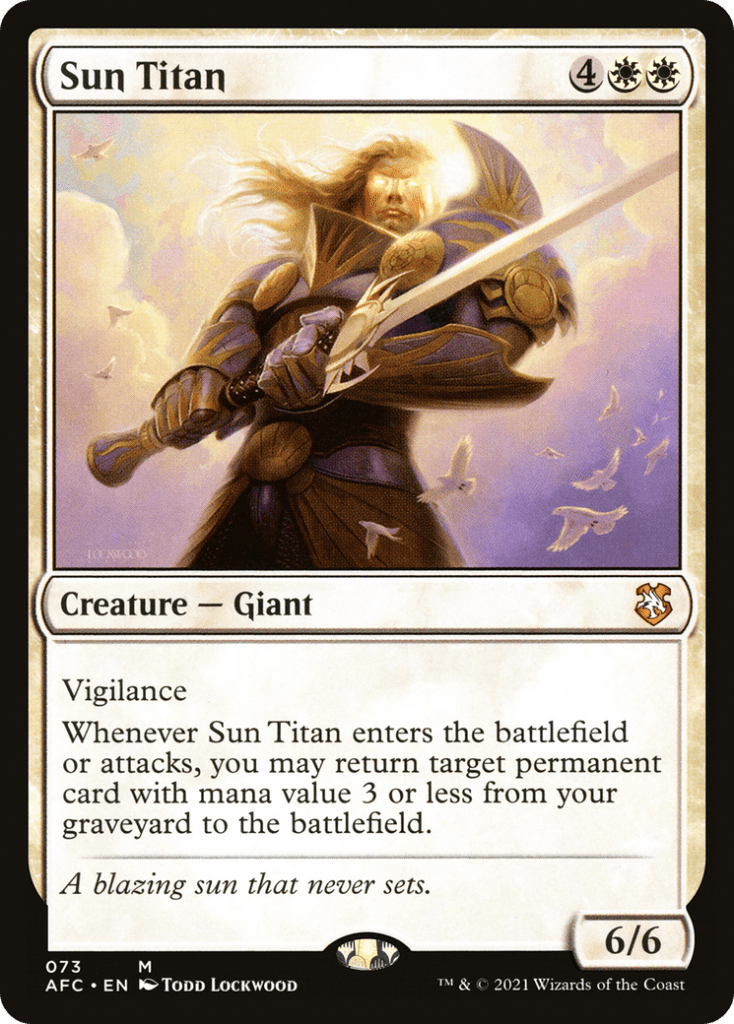
Sometimes the cards you draw just don’t allow for that, however, so attrition is also a perfectly viable backup plan. Your reanimation spells will typically cost much less than your opponents will spend on their biggest creatures, so you will spend far fewer resources while exerting similar, if not stronger, pressure on the table.
Cards like Sun Titan are ideal for this plan, as you can use them to accrue significant value over time through creatures like Eternal Witness, Loyal Retainers, and Wood Elves, fetchlands like Bloodstained Mire, or even previously destroyed mana rocks, so having a big creature or two that can fill this role is very helpful when possible.
The attrition approach also allows you to keep mana up more easily for interaction, should the need arise, allowing you to protect your cards, destroy others, or simply buy time to assemble and cast a winning combination of cards.
Knowing all of that, here is the game plan I typically use:
- All parts of the game: Proactively keep graveyard hate off the table. Rest in Peace, Containment Priest, Relic of Progenitus, Nihil Spellbomb, and their ilk will shut you down hard, so keeping at least 1 piece of spot removal for these on hand should be a priority. If you don’t have an answer when one of these comes down, aggressively draw or tutor for one ASAP.
- Early game: Finding ways to load up the graveyard and ramp mana are my two biggest priorities. Hermit Druid, Life from the Loam, Entomb, Buried Alive, Faithless Looting, Wheel of Misfortune, Frantic Search, and Bazaar of Baghdad are all great ways to do the former; low CMC mana ramp spells like Nature’s Lore and/or mana rocks like Arcane Signet and Sol Ring will take care of the latter.
If your deck has the ability to draw or tutor cards, start looking for cards that let you do these things or start accumulating reanimation spells or combo pieces.
- Mid game: You should aim to have a reanimation target in your graveyard by turn 4-5, as well as at least 1 way to do bring it into play. At this point, you want to pace yourself if the table is keeping up with you – don’t spend every reanimation spell in your hand unless you only have 1, and start looking for ways to wear your opponents down.
If you’re working toward a combo to kill the table with a creature like Kokusho the Evening Star, be more aggressive in using your tutors to acquire combo pieces. Don’t be afraid to wipe the board a time or two if it will put you ahead in the long run.
- End game: Ideally, your opponents have been on the defensive for a while or are getting there now. Be aggressive about taking weakened players out of the game at this point, but don’t leave yourself defenseless if someone else still has a powerful position at the table. If you have a combo, look for a time to execute it when the potential for interruption is low to nonexistent.
Should everything go as planned, you should be victorious at this point! If not, there’s always next game. Remember that no deck is going to win 100% of the time, but as long as it did what it was supposed to do and you had fun playing, that’s still a good game in my book.
Other MTG Articles You Might Enjoy
Braden is a founder of Assorted Meeples and has been a gamer & writer with a vivid imagination all his life. Don’t believe us? Check out his excitement when meeting Goosebumps author R.L. Stine as a kid! An avid Magic: The Gathering spellslinger for over 15 years, you can always convince him to shuffle up for a game (or three!) of Commander.
